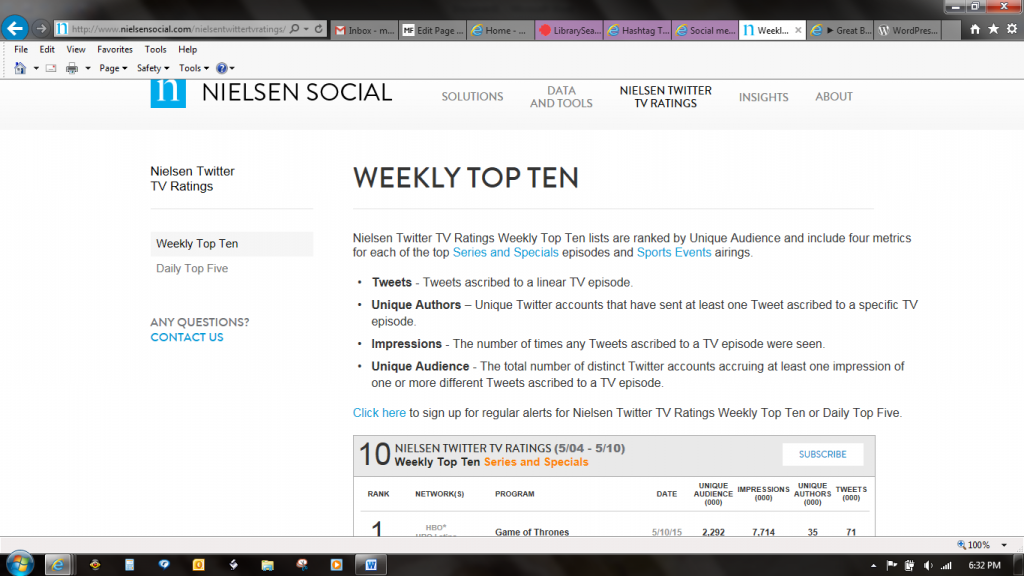Seeing as our lectorial yesterday was all about remix culture, which I’ve already blogged about, today I thought I’d upload an article I wrote for my group project about Twitter and TV audiences. It’s a bit long, and it needs a bit of polishing yet (it’s only a draft) but I hope you enjoy it!
It seems like an age ago that the symbol # simply meant a number; nowadays it is synonymous with the twitter hashtag, an online paper trail that links together conversations from hundreds of users around the world. When talking about the interactivity of modern TV audiences, it’s impossible to acknowledge the importance the humble hashtag has gained in allowing people to connect both with broadcast content and each other.
The very term ‘broadcast’ refers to mass communication, implying a universal form of entertainment that way uniformly experienced by a wide range of people. For the first fifty years, this was the truth of TV; even if audiences interpreted a TV show in different ways, it was still very much a one-way conversation in terms of their input into the creation of a show. Today, twitter (and social media) has changed all that. As Chris Copeland wrote in Adweek, “TV has a new love — that little blue Twitter bird.”
Stephanie Moritz in PRweek explains the “new kind of interactive TV” created by Twitter, saying that “Twitter and TV go hand in hand.” Moritz refers to the way in which audience members live, widely broadcast comments can be picked up by TV producers and in turn affect the way the show is made. While this has always been possible in slow motion (fans complaints must always be taken into consideration if a show is to be successful), Twitter makes that process instantaneous.
A simple example is that of The Block, an Australian renovation reality show that frequently shows fans’ tweets on the screen and invites them to take part in online quizzes that get broadcast at the end of an episode, the hashtag function allowing tweets about the show to be conveniently packaged into one stream. This gives viewers another level of engagement with the show that makes them feel like they are actively participating and interacting with the program.
But this isn’t complete interactivity, because it doesn’t affect the outcome of the show. A better example of this would be British comedy panel show The Last Leg, during which twitter polls are taken, fans’ joke answers to questions get read aloud and viewers have the chance to ask ‘#isitokay’ questions that form the basis of panelists’ discussions. Have a look at this example about The Great British Bakeoff:
As Moritz says, “a well-timed tweet can create an immediate buzz”, and there’s no doubt that interactive TV like this gets Hills’ audience engaged with the show; frequently he suggests humourous hashtags that trend on Twitter while the show is on air. But the importance of the hashtag relates not just to the interactivity of TV audiences to the show itself, but to each other: “viewers follow along on social media to converse with like-minded fans”, says Moritz. Twitter allows audiences to not just actively influence the content of a show, but to share, discuss, argue and bond with others with similar interests.
Furthermore, Twitter’s capacity for fostering interactivity has commercial benefits as well, such as more accurate TV ratings. Neilsen, who for many years have been in charge of measuring TV ratings, but have been limited by the ultimately uninformative single number that is how many households are watching a particular program at a particular time. It’s unfortunately a rather inaccurate number, as it’s difficult to distinguish between members of a household and to understand their qualitative engagement with a program. In the age of Twitter, however, Neilsen uses a set of four criteria to assess Tweets and create a new ratings system. There are a few flaws, such as the limited and specific demographic that uses Twitter, however as an accompaniment to the existing ratings system it provides valuable data about audience engagement.
However, it is important to remember that there are still many flaws in using Twitter as a tool to engage with TV audiences. Chris Copeland looks at the use of Twitter at the 2012 Grammy’s, and notices a few key difficulties, such as the sheer mass of tweets that can be created: “Since the volume of tweets (at 200,000 per minute) [during the 2012 Grammy’s] would be the equivalent of a full-length novel every hour, I’m guessing no one read every single comment made about the show.” It’s a valuable point; producers and consumers alike need to be able to filter tweets for relevance in order to be able to gain information and engagement from Twitter users. Furthermore, Copeland highlights the tendency of Twitter fans to focus on events rather than ongoing TV series, saying that “Massive watercooler moments like the Super Bowl, the Oscars or even the presidential elections are ideal for social TV . . . but it’s not there yet for social TV during the average drama or sitcom . . .” The article is a few years old now, and I would argue that Twitter users are tweeting more regularly now, but Copeland’s point is still relevant as big TV events still get much more Twitter coverage than ongoing series.
It has been argued that broadcast TV can bring us together by creating an experience that can be simultaneously shared by large populations, and the interactivity encouraged by Twitter only enhances this. As Stephanie Moritz writes, “TV is alive and social”, and we can only assume that the rise and rise of Twitter will lead to a greater and greater fluidity between TV producers and audiences
